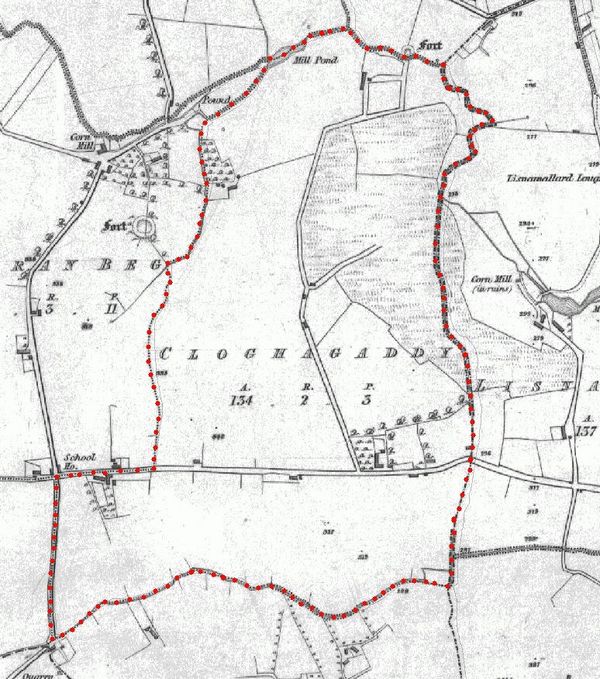Cloghagaddy
| This townland has been mapped on OSM, click the following link to see : Cloghagaddy |
Cloghagaddy is a townland in South-Eastern County Fermanagh, Northern Ireland. May previously be known as 'Barilstown'
Area 135:1:12
Etymology
- 1738 - Johnston to Thompson "called by the name Barilstown alias Cloghegaddy, situated in the Manor of Rathmoran" (Book 94 Page 153 No 65725 Reg 23 Feb 1738
- 1751 - Cloghagaddy
- 1834 - Cloch a' Ghadaídhe "the thief's stone"
- 1834 - Cluain Cairn "lawn or meadow of the cairn or heap
- 1875 - "stone castle of the thief"
- 2004 - Cloch an Ghadaí "stone of the thief"
Cloghagaddy (Irish: Cloch an Ghadaí) mean “stone of the thief” (only 1 in Ireland)
There is a small church which is known as "Clogh Church" (now in ruins) which suggests that the original name for this townland was Clogh meaning "stone". When Dr P McKay of the Ulster Place Names project came to talk to us, he explained that the more accurate translation would be the "Thief's stone". It is believed that after the incident involving the thief being strangled this townland then became known as Cloghagaddy meaning "the thiefs stone".
Cloghagaddy takes its name from a large stone on the East side where a thief was hanged. The stone is about the height of a man, terminating like a sugar loaf – a man stealing sheep was found hanged. A popular local saying “the sheep hung them over the stone”
1830's Map
1841-61 Population
Cloghagaddy isnt mentioned on the 1861 Census. It could be rolled into one of the neighbouring townlands, however, we cant be sure.
Griffiths Valuation 1862
| Occupier | Lessor | Tenement |
|---|---|---|
| Joseph Mills | Andrew Thompson | House, Offices & Land |
| Alex Campbell | John Johnston | House, Offices & Land |
| Ellen Little | Andrew Thompson | House, Offices & Land |
| Robert Little | Andrew Thompson | House, Offices & Land |
| James Forster | Alex Campbell | House, Offices & Land |
1901 Census
| Head of Family | Landholder (if different) |
|---|---|
| Mark Little | |
| Joseph Mills |
Surnames in 2005
- Irwin
- Downey
Clogh Stone
Click here for page on Cloughagaddy Stone
Clogh Methodist Church
This little church no longer exists though the building now used as a farm building is now recognisable from the main road. It closed during the sixties because like many other similar churches there was not the population to support it. This little clip from the Impartial Reporter of 1939 is a reminder of the days when everyone was expected to take his or her part in providing a social gathering.
Reunion at Clough
Notwithstanding that the country was covered with snow there was a well filled house at the annual social meeting held in Clough Methodist Church, near Magheraveeley, on Thurs. 5th inst. Rev.Fredk. T.Parker presided. The following con-tributed to the programme-Solos, Miss Morrison, Lisnaskea; duets, Miss M’Anuff and Miss Plunkett, Lisnaskea; and Miss Johnston and Miss M’Cullagh; trio, the Misses Pheobe and Madge Elliott and Alice Armstrong; quartette, Misses Elliott and Armstrong, Rev.F.T..Parker and Mr James Elliott;choruses, Misses Elliott and Arnstrong, Rev.F.T.LParker, and Messrs. J. Kettyle and J. Elliott; recitations, Misses Minnie Johnston, Cissie Beacom, Beatrice Johnston, May Johnston, Ruby Beacom and Masters William Mayne, Albert Mayne and Jack Mayne; Addresses were delivered by Rev.R.J.Kyle,Lisnaskea.. Prizes were distributed to the Sunday school children by Miss Holmes, Lisnaskea. The accompanists were Miss Madge Elliott, Miss Alice Armstrong.– Courtesy of the Impartial Reporter - 12th January 1939
The Strand
Local people refer to the 'strand' as being at the cross-roads where the Golan Road meets the Cloghagaddy Road. There used to be a watering hole for cattle on the upper side of the road. When the level of the water rose it used to run across the road as a shallow flow, leaving sand and small stones along the road. In later years this feature was drained by a pipe under the road.
Wikipedia defines a strand as a beach, a geological formation consisting of loose rock particles along the shoreline of a body of water.
In this case the body of water was not very big, but the name has been used for generations to refer to this road junction.
